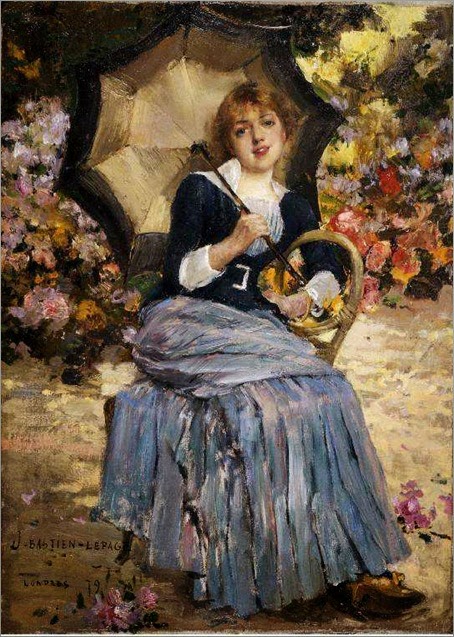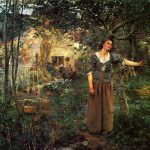
Bastien-Lepage was born in the village of Damvillers, Meuse, and spent his childhood there. Bastien’s father grew grapes in a vineyard to support the family. His grandfather also lived in the village; his garden had fruit trees of apple, pear, and peach up against the high walls.
Bastien took an early liking to drawing, and his parents fostered his creativity by buying prints of paintings for him to copy.
After exhibiting works in the Salons of 1870 and 1872, which attracted no attention, in 1874 his Portrait of my Grandfather garnered critical acclaim and received a third-class medal. He also showed Song of Spring, an academically oriented study of rural life, representing a peasant girl sitting on a knoll above a village, surrounded by wood nymphs.
His Portrait of Mlle Sarah Bernhardt (1879), painted in a light key, won him the cross of the Legion of Honour. In 1879 he was commissioned to paint the Prince of Wales. In 1880 he exhibited a small portrait of M. Andrieux and Joan of Arc listening to the Voices (now in the Metropolitan Museum of Art); and in the same year, at the Royal Academy, the little portrait of the Prince of Wales.
In 1881 he painted The Beggar and the Portrait of Albert Wolf; in 1882 Le Père Jacques; in 1885 Love in a Village, in which we find some trace of Gustave Courbet‘s influence. His last dated work is The Forge (1884).
Succumbing to Poor Health
Between 1880 and 1883 he traveled in Italy. The artist, long ailing, had tried in vain to re-establish his health in Algiers. He died in Paris in 1884, when planning a new series of rural subjects. His friend, Prince Bojidar Karageorgevitch, was with him at the end and wrote:[
At last he was unable to work anymore; and he died on the 10th of December, 1884, breathing his last in my arms. At his grave’s head his mother and brother planted an apple-tree.
Bojidar Karageorgevitch
In March and April 1885, more than 200 of his pictures were exhibited at the Ecole des Beaux-Arts. In 1889 some of his best-known work was shown at the Paris Exposition Universelle.
Among his more important works, may also be mentioned the portrait of Mme J. Drouet (1883); Gambetta on his death-bed, and some landscapes; The Vintage (1880), and The Thames at London (1882).
The Little Chimney-Sweep was never finished. A museum is devoted to him at Montmédy. A statue of Bastien-Lepage by Rodin was erected in Damvillers. An obituary by Prince Bojidar Karageorgevitch, appeared in the Magazine of Art (Cassell) in 1890. Source: Wikipedia.




